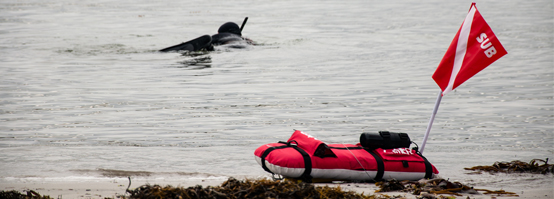Spearfishing Basics

Trust your gear and learn to useit. It is important to familiarise yourself with the function of your gear. Target practice on a submerged plastic bottle out on the sand is a good way to become acquainted with loading, discharging and handling your equipment. Remember, spearguns are not toys and you risk serious injury if you ignore the potential energy contained within a loaded speargun. Note, it is an offence to load a speargun out of the water. Anyway, fish are found in the water. The effective range of most spearguns is very limited owing to water density. It is therefore crucial to improve your physiology and skills in the quest for improved catches.
Getting Started
You may be wondering which location to begin your diving. It won’t be long though till you have a range of preferred locations. The idea is to try new areas and you can do this by simply buddy up with someone else. Generally speaking, experienced divers travel extensively and dive with many different people to build their local knowledge and diving skills.
It is suggested that you start diving in sheltered areas and move out as skill and confidence improves. The length of time it takes to become confident is dependent on the individual and whether or not you are diving with experienced buddies.
Equalizing Ear Pressure
When taking up diving it is necessary to learn how to “equalize your ears”.
As water is much heavier than air, the deeper you descend the more pressure is brought to bear on your body. At approximately 10 meters the pressure is equal to two atmospheres. The water pressure on your ears as you descend is usually painful and can cause damage. However there is a simple solution. From the back of one’s throat up to the ear cavities exist two fine tubes. These are called the “Eustachian tubes”. Their purpose is the equalization of pressure. When one ascends in an aircraft the pressure change is adjusted with these tubes, usually with minor movements of the jaw. However in diving the pressure change is often very sudden and unless these tubes are working well the ears will suffer pain and inhibit descending. The first thing to know is NEVER force yourself through pain to get deeper in the water. Many people have damaged their ear drums by doing this. If there is pain you must ascend. To equalize or “clear” one’s ears it requires you to hold onto your nose while you descend and as soon as any pressure is felt a gentle blow into your now-blocked nose will push air up these Eustachian tubes and bring the pressure in the ear cavities up to the outside water pressure. Dive masks are made so it is possible to take hold of your nose with your fingers.
With a working knowledge and a gentle approach the chance of your diving being interrupted by major ear trouble is very minimal.
The Buddy System
We have all heard the advice, “Don’t dive alone”. This is good advice, however it needs to be expanded to be really effective. Add to the above, “Ensure you and your dive buddy have the knowledge and are drilled on how to handle a blackout or samba situation”. Good freediving / spearfishing clubs will educate their members and it is a major reason why joining a club is beneficial. In addition to this it is important to adopt or develop a buddy system of diving that stresses safety. This is vital when the diving depth is increased. When diving in deep water, one diver up and one diver down, with the surface diver constantly watching his buddy is a good start. If the diving depth exceeds the water visibility level, then the safety diver would need to follow the diver’s float rope. When the diver below returns to the surface they are watched until at least 10 seconds after
taking their first breath to ensure they are fully ok.
Buddy systems break down only when there is insufficient communication between partners. A dive partner should know what the other diver is doing so they can coordinate actions. Dive buddies should be of similar abilities and purpose. For example, if one partner cannot exceed 10 metres depth they shouldn’t be watching out for someone diving 20 metres. Your safety and life may well rest in your partner’s hands and vice versa, so make a point on ensuring you and your dive buddy know what to do in an emergency and have practiced it.
Hyperventilation
One of the most dangerous practices for a diver is hyperventilation. This is the major cause of blackouts.
The term means: breathing at an increased rate or depth than what is required by the body. It is done by divers in a false hope that they will get more oxygen. They take rapid or many long deep breaths before diving. In general living the oxygen level in the blood stream is around 98% saturated. To bring this up to 100%
Remember
- Never wait for pain or strong pressure to clear ones ears. It is good practice to clear them once or twice a metre starting from the surface, especially when new to the practice.
- If you have a cold or excess mucus in the head these tubes often get blocked. You are better off not diving than risking damage to
the ear drums. Using excess force to clear your ears often enflames the tubes and prevents diving for a much longer period. - If there is difficulty equalizing, try moving your jaw up and down and side to side while clearing. This often has the effect of allowing air through these tubes.
- When new to diving it may take some time and gradual improvements to get these tubes operating well. It varies from individual
to individual. - Certain foods and drinks are mucus forming depending on individual reactions. Good results are often obtained from removing these foods from your diet. It can take a bit of experimenting to locate these. Milk, cheese, wine and beer are some of the more common mucus forming foods that when omitted or limited in ones diet can benefit the clearing of ears.
With a working knowledge and a gentle approach the chance of your diving being interrupted by major ear trouble is very minimal.
